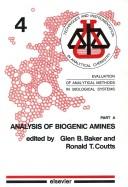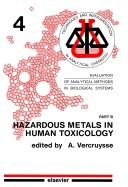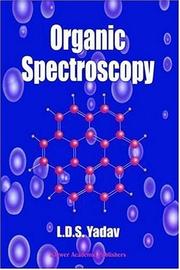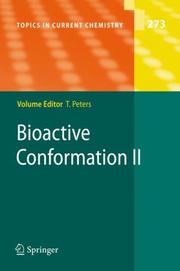| Listing 1 - 10 of 10 |
Sort by
|

ISBN: 0444421106 9786611756116 1281756113 0080875513 9780444421104 Year: 1982 Volume: vol 4 part A Publisher: Amsterdam ; New York : Elsevier,
Abstract | Keywords | Export | Availability | Bookmark
 Loading...
Loading...Choose an application
- Reference Manager
- EndNote
- RefWorks (Direct export to RefWorks)
EVAL ANAL METH BIOL SYSTEMS PART A
Biochemistry --- Technique. --- Aminen / in het lichaam. (Versch. onderwerpen) --- Amines. Biochimie analytique. (Mélanges) --- Amines / dans l'organisme. (Mélanges) --- Aminen. Biochemie (Analytische). (Versch. onderwerpen) --- Amines in the body. --- Amines --- Organic compounds --- Deamination --- Body composition --- Analysis.
Book
ISBN: 9780128226544 9780128227992 0128227990 0128226544 Year: 2022 Publisher: London : Elsevier,
Abstract | Keywords | Export | Availability | Bookmark
 Loading...
Loading...Choose an application
- Reference Manager
- EndNote
- RefWorks (Direct export to RefWorks)
Analytical Techniques in Biosciences: From Basics to Applications presents comprehensive and up-to-date information on the various analytical techniques obtainable in bioscience research laboratories across the world. This book contains chapters that discuss the basic bioanalytical protocols and sample preparation guidelines. Commonly encountered analytical techniques, their working principles, and applications were presented. Techniques, considered in this book, include centrifugation techniques, electrophoretic techniques, chromatography, titrimetry, spectrometry, and hyphenated techniques. Subsequent chapters emphasize molecular weight determination and electroanalytical techniques, biosensors, and enzyme assay protocols. Other chapters detail microbial techniques, statistical methods, computational modeling, and immunology and immunochemistry.
Life sciences --- Analytical biochemistry --- Analytical chemistry. --- Biochemistry --- Sciences de la vie. --- Biochimie analytique --- Biochimie --- Chimie analytique. --- Research --- Methodology. --- Technique. --- Technique --- Analytical biochemistry. --- Biosciences --- Sciences, Life --- Science --- Analytic biochemistry --- Bioanalytic chemistry --- Bioanalytical chemistry --- Analytical chemistry

ISBN: 9780444422071 0444422072 1281778370 9781281778376 9786611778378 6611778373 0080875521 9780080875521 0444417443 0444425349 Year: 1984 Volume: v. 4, pt. B Publisher: New York Elsevier
Abstract | Keywords | Export | Availability | Bookmark
 Loading...
Loading...Choose an application
- Reference Manager
- EndNote
- RefWorks (Direct export to RefWorks)
Electroanalysis as a representative of the wet-chemical methods has many advantages, such as: selectivity and sensitivity, nothwithstanding its inexpensive equipment; ample choice of possibilities and direct accessibility, especially to electronic and hence automatic control even at distance; automated data treatment; and simple insertion, if desirable, into a process-regulation loop. There may be circumstances in which an electroanalytical method, as a consequence of the additional chemicals required, has disadvantages in comparison with instrumental techniques of analysis; however the above-mentioned advantages often make electroanalysis the preferred approach for chemical control in industrial and environmental studies. This book provides the reader with a full understanding of what electroanalysis can do in these fields. It presents on the one hand a systematic treatment of the subject and its commonly used techniques on a more explanatory basis, and on the other it illustrates the practical applications of these techniques in chemical control in industry, health and environment. As such control today requires the increasing introduction of automation and computerization, electroanalysis with its direct input and/or output of electrical signals often has advantages over other techniques especially because recent progress in electronics and computerization have greatly stimulated new developments in the electroanalysis techniques themselves. Part A looks systematically at electroanalysis while more attention is paid in Part B to electroanalysis in non-aqueous media in view of its growing importance. The subject is rounded off in Part C by some insight into and examples of applications to automated chemical control.
Metals --- Analysis. --- toxicity --- Toxicology. --- Electrochemical analysis --- Aminen / in het lichaam. (Versch. onderwerpen) --- Amines. Biochimie analytique. (Mélanges) --- Amines / dans l'organisme. (Mélanges) --- Aminen. Biochemie (Analytische). (Versch. onderwerpen) --- Analytical methods --- Automation --- Electrochemistry. --- Electrochemical analysis. --- Analytical methods. --- Automation. --- Analyse électrochimique.

ISBN: 9781402025754 940172508X 9789401725088 1402025742 1402025750 9781402025747 Year: 2005 Publisher: Dordrecht : Springer Netherlands : Imprint: Springer,
Abstract | Keywords | Export | Availability | Bookmark
 Loading...
Loading...Choose an application
- Reference Manager
- EndNote
- RefWorks (Direct export to RefWorks)
Organic Spectroscopy presents the derivation of structural information from UV, IR, Raman, 1H NMR, 13C NMR, Mass and ESR spectral data in such a way that stimulates interest of students and researchers alike. The application of spectroscopy for structure determination and analysis has seen phenomenal growth and is now an integral part of Organic Chemistry courses. This book provides: A logical, comprehensive, lucid and accurate presentation, thus making it easy to understand even through self-study; Theoretical aspects of spectral techniques necessary for the interpretation of spectra; Salient features of instrumentation involved in spectroscopic methods; Useful spectral data in the form of tables, charts and figures; Examples of spectra to familiarize the reader; Many varied problems to help build competence ad confidence; A separate chapter on ‘spectroscopic solutions of structural problems’ to emphasize the utility of spectroscopy. Organic Spectroscopy is an invaluable reference for the interpretation of various spectra. It can be used as a basic text for undergraduate and postgraduate students of spectroscopy as well as a practical resource by research chemists. The book will be of interest to chemists and analysts in academia and industry, especially those engaged in the synthesis and analysis of organic compounds including drugs, drug intermediates, agrochemicals, polymers and dyes. L.D.S. Yadav is currently Professor in the Department of Chemistry, University of Allahabad, India.
Chemistry. --- Organic Chemistry. --- Analytical Chemistry. --- Analytical biochemistry. --- Chemistry, Organic. --- Chimie --- Biochimie analytique --- Chimie organique --- Separation (Technology). --- Spectrum analysis. --- Chemistry --- Physical Sciences & Mathematics --- Biochemistry --- Spectrum analysis --- Chemistry, Organic --- Organic Chemistry --- Organic chemistry --- Analysis, Spectrum --- Spectra --- Spectrochemical analysis --- Spectrochemistry --- Spectroscopy --- Analytical chemistry. --- Organic chemistry. --- Analytic biochemistry --- Chemistry, Analytic --- Interferometry --- Optics --- Radiation --- Wave-motion, Theory of --- Absorption spectra --- Light --- Spectroscope --- Qualitative --- Spectrometry --- Analysis, Chemical --- Analytic chemistry --- Chemical analysis
Book
ISBN: 9783540882428 9783540882411 3540882413 3540882421 9783642028267 3642028268 3642028276 9783642028274 9786612833489 1282833480 3642426174 9786612833496 1282833499 Year: 2010 Publisher: Berlin, Heidelberg Springer Berlin Heidelberg
Abstract | Keywords | Export | Availability | Bookmark
 Loading...
Loading...Choose an application
- Reference Manager
- EndNote
- RefWorks (Direct export to RefWorks)
For the first time, distinguished scientists from key institutions worldwide provide a comprehensive approach to optical sensing techniques employing the phenomenon of guided wave propagation for chemical and biosensors. This includes both state-of the-art fundamentals and innovative applications of these techniques. The authors present a deep analysis of their particular subjects in a way to address the needs of novice researchers such as graduate students and post-doctoral scholars as well as of established researchers seeking new avenues. Researchers and practitioners who need a solid foundation or reference will find this work invaluable. This first of two volumes contains eight chapters covering planar waveguides for sensing, as well as sensing techniques based on plasmonic waveguides.
Chemistry. --- Analytical Chemistry. --- Industrial Chemistry/Chemical Engineering. --- Medical Biochemistry. --- Optics, Optoelectronics, Plasmonics and Optical Devices. --- Analytical biochemistry. --- Chemical engineering. --- Biochemistry. --- Chimie --- Biochimie analytique --- Génie chimique --- Biochimie --- Biosensors. --- Chemical detectors. --- Optical detectors. --- Optical wave guides. --- Optics, Lasers, Photonics, Optical Devices. --- Biodetectors --- Biological detectors --- Biological sensors --- Biomedical detectors --- Biomedical sensors --- Detectors --- Medical instruments and apparatus --- Physiological apparatus --- Chemical sensors --- Chemical apparatus --- Light-sensitive cells --- Light-sensitive detectors --- Light sensor photodevices --- Photodetectors --- Photodevices, Light sensor --- Photoelectric detectors --- Photosensors --- Optical transducers --- Optoelectronic devices --- Biological chemistry --- Chemical composition of organisms --- Organisms --- Physiological chemistry --- Biology --- Chemistry --- Medical sciences --- Chemistry, Industrial --- Engineering, Chemical --- Industrial chemistry --- Engineering --- Chemistry, Technical --- Metallurgy --- Analytic biochemistry --- Biochemistry --- Chemistry, Analytic --- Composition --- Bioanalytic chemistry --- Bioanalytical chemistry --- Analytical chemistry --- Analytical chemistry. --- Medical biochemistry. --- Lasers. --- Photonics. --- Analysis, Chemical --- Analytic chemistry --- Chemical analysis --- New optics --- Optics --- Light amplification by stimulated emission of radiation --- Masers, Optical --- Optical masers --- Light amplifiers --- Light sources --- Nonlinear optics --- Optical parametric oscillators --- Medical biochemistry --- Pathobiochemistry --- Pathological biochemistry --- Pathology
Book
ISBN: 9783540791188 3540791175 9783540791171 3540791183 Year: 2008 Publisher: Berlin, Heidelberg : Springer Berlin Heidelberg : Imprint: Springer,
Abstract | Keywords | Export | Availability | Bookmark
 Loading...
Loading...Choose an application
- Reference Manager
- EndNote
- RefWorks (Direct export to RefWorks)
Nuclear Magnetic Resonance is a powerful tool, especially for the identification of 1 13 hitherto unknown organic compounds. H- and C-NMR spectroscopy is known and applied by virtually every synthetically working Organic Chemist. Con- quently, the factors governing the differences in chemical shift values, based on chemical environment, bonding, temperature, solvent, pH, etc. , are well understood, and specialty methods developed for almost every conceivable structural challenge. Proton and carbon NMR spectroscopy is part of most bachelors degree courses, with advanced methods integrated into masters degree and other graduate courses. In view of this universal knowledge about proton and carbon NMR spectr- copy within the chemical community, it is remarkable that heteronuclear NMR is still looked upon as something of a curiosity. Admittedly, most organic compounds contain only nitrogen, oxygen, and sulfur atoms, as well as the obligatory hydrogen and carbon atoms, elements that have an unfavourable isotope distribution when it comes to NMR spectroscopy. Each of these three elements has a dominant isotope: 14 16 32 16 32 N (99. 63% natural abundance), O (99. 76%), and S (95. 02%), with O, S, and 34 14 S (4. 21%) NMR silent. N has a nuclear moment I = 1 and a sizeable quadrupolar moment that makes the NMR signals usually very broad and dif cult to analyse.
Chemistry. --- Organic Chemistry. --- Organometallic Chemistry. --- Analytical Chemistry. --- Inorganic Chemistry. --- Polymer Sciences. --- Catalysis. --- Analytical biochemistry. --- Chemistry, inorganic. --- Chemistry, Organic. --- Polymers. --- Chimie --- Biochimie analytique --- Chimie organique --- Polymères --- Catalyse --- Electronic books. -- local. --- Nuclear magnetic resonance spectroscopy. --- Phosphorimetry. --- Biochemistry --- Analytical Chemistry --- Chemistry --- Physical Sciences & Mathematics --- Luminescence analysis --- Phosphorescence analysis --- Phosphorimetric analysis --- NMR spectroscopy --- Spectroscopy, NMR --- Spectroscopy, Nuclear magnetic resonance --- Analytical chemistry. --- Inorganic chemistry. --- Organic chemistry. --- Organometallic chemistry. --- Nuclear spectroscopy --- Knight shift --- Chemistry, Analytic --- Activation (Chemistry) --- Chemistry, Physical and theoretical --- Surface chemistry --- Polymere --- Polymeride --- Polymers and polymerization --- Macromolecules --- Inorganic chemistry --- Inorganic compounds --- Analytic biochemistry --- Organic chemistry --- Bioanalytic chemistry --- Bioanalytical chemistry --- Analytical chemistry --- Ressonància magnètica nuclear. --- Compostos orgànics --- Síntesi. --- Organometallic chemistry . --- Polymers . --- Analysis, Chemical --- Analytic chemistry --- Chemical analysis --- Chemistry, Organometallic --- Metallo-organic chemistry --- Chemistry, Organic --- Organometallic chemistry --- Polymers --- Catalysis
Periodical
ISSN: 26292742
Abstract | Keywords | Export | Availability | Bookmark
 Loading...
Loading...Choose an application
- Reference Manager
- EndNote
- RefWorks (Direct export to RefWorks)
Analytical chemistry --- Analytical biochemistry --- Biosensors --- Chemistry Techniques, Analytical --- Biosensing Techniques --- Biochemical Phenomena --- Chimie analytique --- Biochimie analytique --- Biocapteurs --- Biosensors. --- Analytical biochemistry. --- Analytical chemistry. --- Biochemical Concepts --- Biochemical Phenomenon --- Biochemical Process --- Phenomena, Biochemical --- Biochemical Processes --- Biochemical Concept --- Concept, Biochemical --- Concepts, Biochemical --- Phenomenon, Biochemical --- Process, Biochemical --- Processes, Biochemical --- Molecular Biology --- Biosensing Technics --- Bioprobes --- Electrodes, Enzyme --- Bioprobe --- Biosensing Technic --- Biosensing Technique --- Biosensor --- Electrode, Enzyme --- Enzyme Electrode --- Enzyme Electrodes --- Technic, Biosensing --- Technics, Biosensing --- Technique, Biosensing --- Techniques, Biosensing --- Wearable Electronic Devices --- Microchemistry --- Analytical Chemistry Methods --- Analytical Chemistry Techniques --- Analytical Chemistry Method --- Analytical Chemistry Technique --- Chemistry Method, Analytical --- Chemistry Methods, Analytical --- Chemistry Technique, Analytical --- Method, Analytical Chemistry --- Methods, Analytical Chemistry --- Technique, Analytical Chemistry --- Techniques, Analytical Chemistry --- Biodetectors --- Biological detectors --- Biological sensors --- Biomedical detectors --- Biomedical sensors --- Detectors --- Medical instruments and apparatus --- Physiological apparatus --- Analytic biochemistry --- Bioanalytic chemistry --- Bioanalytical chemistry --- Biochemistry --- Chemistry, Analytic --- Analysis, Chemical --- Analytic chemistry --- Chemical analysis --- Chemistry
Periodical
Abstract | Keywords | Export | Availability | Bookmark
 Loading...
Loading...Choose an application
- Reference Manager
- EndNote
- RefWorks (Direct export to RefWorks)
General biochemistry --- biochemie --- General biophysics --- biochemistry --- Analytical biochemistry --- Chemistry, Analytical --- Biochemistry --- Biochimie --- periodicals --- Periodicals --- Périodiques --- Biochemistry. --- Chemistry Techniques, Analytical. --- Biochimie analytique --- Analytical biochemistry. --- Biochemie. --- Analyse biologique --- Biological analysis --- #TS:WDEP --- 57 --- 577.1 --- Biological sciences in general --- Chemical bases of life. Biochemistry and bio-organic chemistry generally --- Analytical Chemistry. --- Chemistry. --- Chemistry --- Health Sciences --- Analytical Chemistry --- Physiology --- Biochemische Analyse --- Zeitschrift --- Online-Ressource --- Biochemie --- Chemische Analyse --- 577.1 Chemical bases of life. Biochemistry and bio-organic chemistry generally --- Périodiques --- EJBIOMO ELSEVIER-E EPUB-ALPHA-A EPUB-PER-FT --- periodicals. --- Analytic biochemistry --- Chemistry, Analytic --- Analyse --- Analytik --- Analytische Chemie --- Physikalische Analyse --- Bioassay --- Biologische Chemie --- Naturstoffchemie --- Physiologische Chemie --- Molekularbiologie --- Chemische Biologie --- Netzpublikation --- Online-Publikation --- Computerdatei im Fernzugriff --- Online-Dokument --- On-line-Dokument --- On-line-Publikation --- Elektronische Publikation --- Periodikum --- Zeitschriften --- Presse --- Fortlaufendes Sammelwerk --- Bioanalytische Chemie --- Bioanalytik --- Analytische Biochemie --- Analytical Chemistry Methods --- Analytical Chemistry Techniques --- Analytical Chemistry Method --- Analytical Chemistry Technique --- Chemistry Method, Analytical --- Chemistry Methods, Analytical --- Chemistry Technique, Analytical --- Method, Analytical Chemistry --- Methods, Analytical Chemistry --- Technique, Analytical Chemistry --- Techniques, Analytical Chemistry --- Chemie --- Bioanalytic chemistry --- Bioanalytical chemistry --- Analytical chemistry --- Chemistry, Analytic. --- Analytic Chemistry --- Chemistry Techniques, Analytical --- Biochimie. --- biochemistry. --- Biological chemistry --- Chemical composition of organisms --- Organisms --- Physiological chemistry --- Biology --- Medical sciences --- Composition

ISSN: 03401022 ISBN: 9783540490807 3540490795 9783540490791 3540490809 Year: 2008 Volume: 273 Publisher: Berlin, Heidelberg Springer-Verlag Berlin Heidelberg
Abstract | Keywords | Export | Availability | Bookmark
 Loading...
Loading...Choose an application
- Reference Manager
- EndNote
- RefWorks (Direct export to RefWorks)
Speci?c binding of a ligand to a receptor is a key step in a variety of biol- ical processes, such as immune reactions, enzyme cascades, or intracellular transport processes. The ligand-receptor terminology implies that the rec- tor molecule is signi?cantly larger than the ligand, and the term bioactive conformation usually characterizes the conformation of a ligand when it is bound to a receptor. In a more general sense, bioactive conformation applies toanymoleculeinabiologicallyrelevantboundstateregardlessofsizecons- erations. Mostofthecontributions tothisbookaddressligandsthat aremuch smaller than their receptors. X-ray crystallography and high resolution NMR spectroscopy are the two main experimental techniques used to study bioactive conformations. The- fore,the twovolumes ofthisbookcover approachesthat use either ofthetwo techniques, or a combination thereof. The combination of X-ray crystallog- phy and NMR spectroscopy is particularly useful when a crystal structure of areceptorprotein,butnotofthereceptorprotein-ligandcomplex,isavailable. Anumberofexperimentaltechniquestoanalyzethebioactiveconformationof aligandwithNMRarebasedontheobservationoftheresonancesignalsofthe free ligand that is in exchange with the bound ligand. Several chapters focus onsuchapproachesthat rangefromclassical transferredNOEexperiments, totransferred dipolar couplings,toSTD (saturation transfer difference) NMR techniques. Incaseswhere tightbinding inthesub-nanomolar rangeprevents the analysis of the bioactive conformation via free ligand signals, the ligand- proteincomplexhas tobeanalyzed withproteinNMR-based techniques orby crystallography.Sincethisareahasbeenthesubjectofmanyreviewsandmo- graphsitwill not be covered here in particular detail. As a unifying theme, all contributionstargetthequestionofhowmolecular recognitionofbiologically active molecules is achieved on the atomic scale. Depending on the research topic the results from these studies have a strong impact not only in basic research but also in several ?elds of application ranging frompharmaceutical applications tothe use of biomolecules as, for example, cryoprotectants.
Chemistry. --- Organic Chemistry. --- Biochemistry, general. --- Physical Chemistry. --- Medicinal Chemistry. --- Analytical Chemistry. --- Analytical biochemistry. --- Chemistry, Organic. --- Physical organic chemistry --- Biochemistry. --- Chimie --- Biochimie analytique --- Chimie organique --- Chimie organique physique --- Biochimie --- Conformational analysis --- Bioactive compounds --- Ligand binding (Biochemistry) --- Molecular Conformation --- Binding Sites --- Ligands --- Nuclear Magnetic Resonance, Biomolecular --- Protein Binding --- Analysis --- Chemistry --- Biochemistry --- Physical Sciences & Mathematics --- 577.354.3 --- Chemoreception --- 577.354.3 Chemoreception --- Conformational analysis. --- Analysis. --- Binding, Ligand (Biochemistry) --- Analysis, Conformational --- Biologically active compounds --- Compounds, Bioactive --- Compounds, Biologically active --- Compounds, Physiologically active --- Physiologically active compounds --- Analytical chemistry. --- Organic chemistry. --- Physical chemistry. --- Medicinal chemistry. --- Dye-ligand affinity chromatography --- Radioligand assay --- Molecular rotation --- Chemicals --- Chemistry, Physical organic. --- Analytic biochemistry --- Chemistry, Analytic --- Chemistry, Physical organic --- Chemistry, Organic --- Chemistry, Physical and theoretical --- Biological chemistry --- Chemical composition of organisms --- Organisms --- Physiological chemistry --- Biology --- Medical sciences --- Organic chemistry --- Composition --- Bioanalytic chemistry --- Bioanalytical chemistry --- Analytical chemistry --- Analysis, Chemical --- Analytic chemistry --- Chemical analysis --- Chemistry, Medical and pharmaceutical --- Chemistry, Pharmaceutical --- Drug chemistry --- Drugs --- Medical chemistry --- Medicinal chemistry --- Pharmacochemistry --- Chemistry, Theoretical --- Physical chemistry --- Theoretical chemistry --- Bioactive compounds - Analysis
Book
ISSN: 03401022 ISBN: 9783540783954 3540783946 9783540783947 3540783954 Year: 2008 Volume: 285 Publisher: Berlin, Heidelberg Springer-Verlag Berlin Heidelberg
Abstract | Keywords | Export | Availability | Bookmark
 Loading...
Loading...Choose an application
- Reference Manager
- EndNote
- RefWorks (Direct export to RefWorks)
see table of contents.
Chemistry. --- Polymer Sciences. --- Analytical Chemistry. --- Nanotechnology. --- Surfaces and Interfaces, Thin Films. --- Organic Chemistry. --- Analytical biochemistry. --- Chemistry, Organic. --- Polymers. --- Surfaces (Physics). --- Chimie --- Biochimie analytique --- Chimie organique --- Polymères --- Nanotechnologie --- Surfaces (Physique) --- Biomolecules --- Nanostructures --- Molecular biology --- Scanning tunneling microscopy --- Atomic force microscopy --- Analysis --- Research --- Molecular Biology --- Nanotechnology --- Microscopy, Scanning Probe --- Microscopy --- Genetics --- Biochemistry --- Natural Science Disciplines --- Miniaturization --- Manufactured Materials --- Technology --- Biological Science Disciplines --- Investigative Techniques --- Disciplines and Occupations --- Diagnostic Imaging --- Chemistry --- Biology --- Technology, Industry, and Agriculture --- Analytical, Diagnostic and Therapeutic Techniques and Equipment --- Technology, Industry, Agriculture --- Diagnostic Techniques and Procedures --- Diagnosis --- Organic Chemistry --- Health & Biological Sciences --- Physical Sciences & Mathematics --- Atomic force microscopy. --- Scanning tunneling microscopy. --- Analysis. --- Research. --- STM (Microscopy) --- AFM (Microscopy) --- Analytical chemistry. --- Organic chemistry. --- Materials --- Thin films. --- Surfaces. --- Scanning probe microscopy --- Nanoscience --- Physics --- Molecular technology --- Nanoscale technology --- High technology --- Organic chemistry --- Surface chemistry --- Surfaces (Technology) --- Analytic biochemistry --- Chemistry, Analytic --- Polymere --- Polymeride --- Polymers and polymerization --- Macromolecules --- Bioanalytic chemistry --- Bioanalytical chemistry --- Analytical chemistry --- Polymers . --- Materials—Surfaces. --- Films, Thin --- Solid film --- Solid state electronics --- Solids --- Coatings --- Thick films --- Analysis, Chemical --- Analytic chemistry --- Chemical analysis --- Biomolecules - Analysis --- Nanostructures - Analysis --- Molecular biology - Research
| Listing 1 - 10 of 10 |
Sort by
|

 Search
Search Feedback
Feedback About UniCat
About UniCat  Help
Help News
News